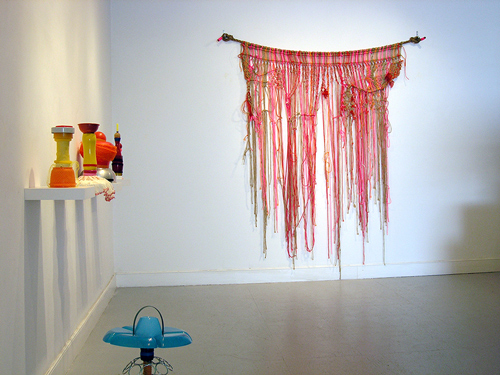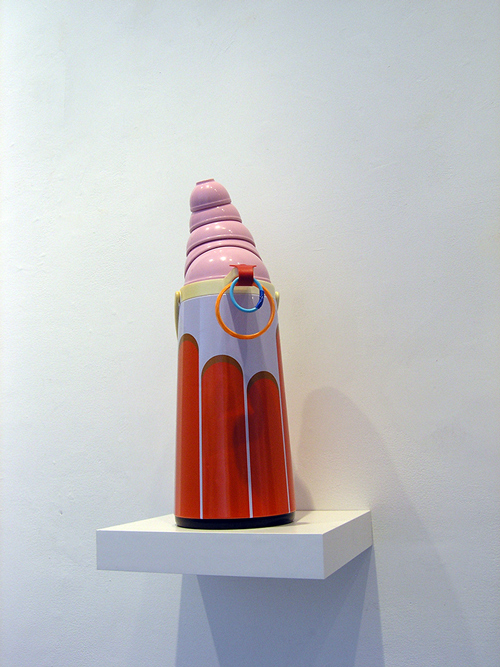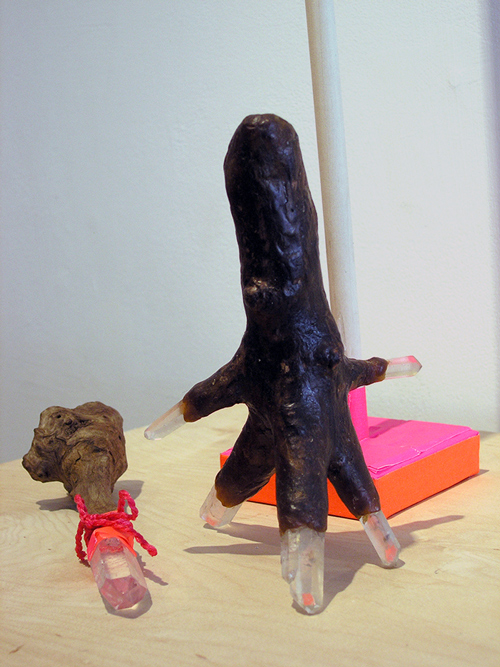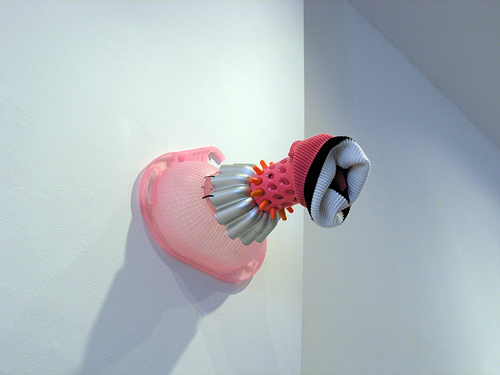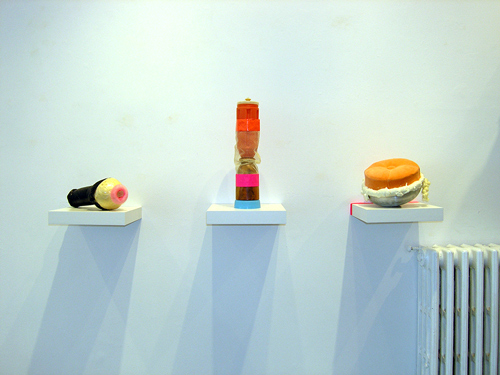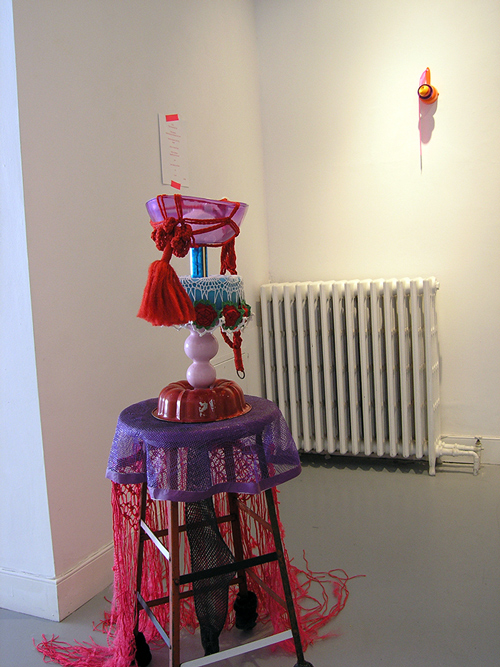The Problem of Having Pets
A Response to the Artwork of KimystreeLoves (a.k.a. Kim Stanford)
June 2019
Written for the exhibition Imaginal, June 1-23, 2019 at Loop Gallery (Toronto, Canada)
Originally published online on the Gallery's blog: http://www.loopgallery.ca/2019/06/07/the-problem-of-having-pets-a-response-to-the-artwork-of-kimystreeloves/ However, as of 2020 the gallery and its website are now sadly defunct.
“Just don’t pet the freaks!”
This was the sole advice my mother gave me on the first day of school. While the other moms were clutching their budding ingenues to their breasts and showering them with kisses, mine was lecturing me from the driver seat about pets. What was she talking about? At six years-old, “pet” was something furry and cute. It peed on the freshly-laid carpet and slobbered on Grandma’s good shoes. Nothing so exciting would be found in the beige hallways of Lakewood Elementary.
Regardless, like so many have learned the hard way: Always take Mom’s advice, even when it doesn’t make sense. Ten brisk minutes later, I found myself surrounded by a motley crew of milk-and-cookie imps—one of whom had just set fire to his house while trying to “cook cereal,” and another in snow pants (in September). Like moths to a flame, the strangest souls in Mrs. Spunkmeyer’s grade 1 class emerged from the padded playsets and slid into my orbit.
They were determined to make me: mother/father/sister/brother/caregiver/guardian/lover/their God. Who were these creatures that seemed suddenly stitched to me like new appendages? Were they friends? Were they my pets? Just how was I supposed to care for them, and for how long? What if they died?! What would happen to me then??
By the time my own mother pulled into the parking lot, I was pinioned to the lot of them. My form was completely obscured by a plurality of pint-sized bodies. All of them flailed about in miscreant adulations as I tried to raise an apologetic hand. Shaking her head steadily like a metronome—what | have | I | made—Mother flung open the passenger-side door and began cleaning out the backseat until the collective body could fit.
Fast forward to middle-age, and my orbit is much larger. Comparable in size to thirty-five years of psychological baggage, this charismatic magnetism I’ve been ‘gifted’ with trails behind me like an industrial fishing net—combing and collecting all kinds of unsuspecting pets in its wake: Big pets, teeny pets, heavy pets, hollow pets, pets with claws, pets with privilege, pet actors, pets with addictions, eco-conscious and politically woke pets, white nationalist and neoliberal pets, occasionally uncanny and symbolically violent pets.
It doesn’t matter the time of day, or the weather. Without fail they follow me home in a silent but vibrant parade of matter. Then they scurry inside when I’m not looking. One might think that I would get mad, or, at the least, defensive about this ongoing influx of unrequited obligations. But then one of them will whimper, or cry, or bat its lashes in a coy display of helplessness, and then I’m helpless to its ethos of co-dependence. So, I let them all stay, accepting more and more pets to the party until no one is really in charge anymore, until hierarchy exists only in the abstract, and we exist inter-dependently—an ecology of pets-becoming.
By now, I know what you must be thinking: How can a person go on like this, swimming in a sea of exponential affinities? Different bodies and biologies all layered like living sediment in a two-bedroom brownstone—it doesn’t sound very comfortable. But then you’d be missing the point.
The virtue of having pets is the problem of having them at all—the unwavering commitment to subtle discomforts, to consistently caring for and communing with your Others. I don’t mind so much that they’re eating me out of house and home, or that the flying ones lay their eggs in the chandelier. It’s the communication factor—that Sisyphean task of achieving some kind of meaningful exchange—that continues to evade me.
Yes, I talk to my pets. We all do. I yammer on and on while I circle the living room in a holding pattern of damage control, addressing them directly with names I’ve imposed on them. I look them square in the eye (or where I assume their eye would be) and I point in a way that is reaching more than locating something, like the desperation of that child actor at the end of E.T.
What is it that you want from me? What are you trying to say? Are you happy living here? Am I your mother?? Are you hungry? Are you in pain? How can I know what you’re feeling? Are you capable of feeling what I feel?
It’s very difficult, you know, mapping the knowledge of one body—one modality of -ness—onto another and hoping for overlap, as if consciousness itself were a territory with its own topographies, its own ports of entry, flanked on all sides by mythical foreboding sirens…
“Uuuuuuuaaaahhhhgggrrwuaaaawuaaaawuaaaaahhhh!
OOooorrrrraahhhhhhmmmmmnnnnnnniiiieeeeeeeeeeeeeeeee!”
I howl from the top of the stairs down at my pets like an ancient Greek orator addressing the polis. I’ve given up now on words and even distinct syllables. I make black noise.[1]Ian Bogost. Alien Phenomenology, or What It’s Like to Be A Thing. University of Minnesota Press, 2012. 33. Maybe, if I try to think about creating an alien sound then some prelinguistic heuristics will emerge? But try as I might, there’s still no response. My pets only stare back at me in silence, offering what I can only interpret as criticism-by-omission of my attempt at a breakthrough.
Lately, I’ve taken to gesturing at them—speaking psycho-choreographically. Pets seem to understand this world better, the one based upon and in the body. It’s a language of materials before anything else. The gesture that they seem to respond to best is the offering. Food was a given in this matter, but soon I found that offerings don’t even have to involve pleasurable outcomes. Sometimes, it’s simply that something is being given, that a legible act of exchange is taking place. Beer boxes, coffee cups, hot water bladders, fingernail clippings and unwanted phonebooks were all met with zeal and avarice as each pet stored away its newfound booty. This meant accepting that my house was now a landfill more than a pet sanctuary, but the polis seemed to like it. In the offering, I found a vehicle in which to travel back and forth between material and symbolic worlds[2]Here, I’m referencing Pierre Bordieu’s concepton of the gift as a “paradigm” of exchange, though he explicitly frames this transcendental process in economic terms. See his Esquisse d’une théorie de la pratique, précédé de trois études d’ethnologie kabyle. Switzerland: Librairie Droz. (Rep. 2000., Paris: Seuil), 1977. English version: Outline of a Theory of Practice. Translated by Richard Nice. Cambridge: Cambridge University Press, 1977.—to ‘walk between’ worlds.[3]Kim Stanford. Interview with Zach Pearl. Studio Visit. Toronto, Ontario, 14 May 2019.
Unfortunately, this vehicular bliss was short-lived, as I soon noticed how capitalistic my little landfill had become. Offerings were no longer neutral affairs. They were perverted into sites of struggle, conflict, disproportion and privation. Pets were forming gangs and extorting other pet-gangs for a considerable share of their bounty. We had to designate the laundry room as a penitentiary. The situation was also quickly leading to environmental collapse. Our ecology of pets-becoming was growing unsustainable as we began asphyxiating from the off-gassing of our materialistic rituals. I needed to find something else, some other gesture that would level the fields of status and goods and property. If I was to continue communicating with my pets, I needed a flatter ontology.[4]Levi Bryant. The Democracy of Objects. Ann Arbor, MI: Open Humanities, 2011.
While on guard-duty in the laundry room, I rummaged through the linens and found a massive outdoor blanket. Without much of a plan, I threw it into my knapsack and headed out the door, proceeding tediously slow so that the agency of my assemblage [5]ane Bennett. Vibrant Matter: A Political Ecology of Things. Duke University Press, 2010. 20-38. could keep up as we crept towards Trinity Bellwoods Park. Mid-ambulation, it began to dawn on me: a carnival, a picnic. Coming down the centre hill, we spotted a massive maple tree and spread out the blanket underneath, meticulously pressing the edges down until the ground was a unified field. One by one, pets climbed on and staked out their individual piece of real estate. Eventually, all and everyone was sitting, imbricated and entangled, grounded and connected by the same material thing. This was the gesture that I was looking for! And then the polyphony of the narrative plane [6]This is a passing but respectful nod to Mikhail Bakhtin’s concept of “polyphony” in which multiple voices are allowed to speak simultaneously and unevenly. He first elucidated this concept in regard to the novel and his analysis of Dostoevsky’s writing. See M.M. Bakhtin. Problems of Dostoevsky's Poetics. Ed. and trans. Caryl Emerson. University of Minnesota Press, 1984. erupted; all my pets lit up in a frenzy of different utterances, as if they each had been busy cultivating a private language all this time. Now, gathered together yet finally decentralized in a carnivalesque moment [7]I am again referencing one of Mikhail Bakhtin’s enduring concepts. His theory of the “carnivalesque” describes how large-scale celebrations and events held in the proverbial public square engender the breakdown of societal conventions, hierarchies and boundaries. In particular, matters of status, class, authority and moral duty are forgone during carnivalesque moments in favour of egalitarianism and freedom of expression., they spoke for the ecstasy of speaking—for the jouissance of granularity.[8]Roland Barthes. “The Grain of the Voice” in Image-Music-Text. Trans. Stephen Heath. New York: Hill and Wang, 1977. And I closed my eyes, and I listened to them for hours—for days it seemed—until the next thing I remember was waking up. My eyes shot open just in time for the morning sunrise and the stranger about to pickpocket me.
“No pets!” I sat up and shouted. (The stranger quickly receded.)
They were gone! All of them gone! But, the longer I sat there the less anxiety I felt. I wasn’t panicked or grief-stricken. In fact, I felt…liberated. I was liberated from them, and they were liberated from me. There was something about the way in which it happened—a letting go that was entirely about coming together—that seemed so consensual, so…right.
As I walked home, I looked around with imaginal eyes. There was no “between worlds”. I had shed some old skin of the mind, and I looked at any kind of difference or border with a renewed skepticism. Rather than seeing separate leaves or stones, I saw only different strata, different articulations of a singular flow. As I neared my neighbourhood, I came across a little boy no more than six pulling a wagon, and in the back was a puppy with a hastily fastened leash around its neck. As the child approached me, he slowed down and grinned ear-to-ear. He was obviously proud of his brand-new pet. We stood there for a while, not saying anything, and then again without much thought, I casually leaned over, picked up the boy, and placed him beside the dog in the wagon.
“Now, talk it out,” I said, patting them both on the head, and I disappeared down the laneway.
ENDNOTES
1. Ian Bogost. Alien Phenomenology, or What It’s Like to Be A Thing. University of Minnesota Press, 2012. 33.
2. Here, I’m referencing Pierre Bordieu’s concepton of the gift as a “paradigm” of exchange, though he explicitly frames this transcendental process in economic terms. See his Esquisse d’une théorie de la pratique, précédé de trois études d’ethnologie kabyle. Switzerland: Librairie Droz. (Rep. 2000., Paris: Seuil), 1977. English version: Outline of a Theory of Practice. Translated by Richard Nice. Cambridge: Cambridge University Press, 1977.
3. Kim Stanford. Interview with Zach Pearl. Studio Visit. Toronto, Ontario, 14 May 2019.
4. Levi Bryant. The Democracy of Objects. Ann Arbor, MI: Open Humanities, 2011.
5. Jane Bennett. Vibrant Matter: A Political Ecology of Things. Duke University Press, 2010. 20-38.
6. This is a passing but respectful nod to Mikhail Bakhtin’s concept of “polyphony” in which multiple voices are allowed to speak simultaneously and unevenly. He first elucidated this concept in regard to the novel and his analysis of Dostoevsky’s writing. See M.M. Bakhtin. Problems of Dostoevsky's Poetics. Ed. and trans. Caryl Emerson. University of Minnesota Press, 1984.
7. I am again referencing one of Mikhail Bakhtin’s enduring concepts. His theory of the “carnivalesque” describes how large-scale celebrations and events held in the proverbial public square engender the breakdown of societal conventions, hierarchies and boundaries. In particular, matters of status, class, authority and moral duty are forgone during carnivalesque moments in favour of egalitarianism and freedom of expression.
8. Roland Barthes. “The Grain of the Voice” in Image-Music-Text. Trans. Stephen Heath. New York: Hill and Wang, 1977.
BIBLIOGRAPHY
Barad, Karen. Meeting the Universe Halfway: Quantum Physics and the Entanglement of Matter and Meaning. Duke University Press, 2007.
Baudrillard, Jean. "The Ecstasy of Communication." (1983) The Anti-Aesthetic: Essays on Postmodern Culture. Hal Foster, Ed. New York: The New Press, 1998.
Deleuze, Gilles and Félix Guattari. A Thousand Plateaus: Capitalism and Schizophrenia. Trans. Brian Massumi. University of Minnesota Press, 1987.
Haraway, Donna J. Simians, Cyborgs, and Women: The Reinvention of Nature. London, UK: Free Association Books, 1991.
Hayles, N. Katherine. How We Became Posthuman: Virtual Bodies in Cybernetics, Literature and Informatics. University of Chicago Press, 1999.
________. My Mother Was a Computer: Digital Subjects And Literary Texts. University of Chicago Press, 2005.
Jarratt, Susan C. and Nedra Reynolds. “The Splitting Image: Contemporary Feminisms and the Ethics
of êthos” in Ethos: New Essays in Rhetorical and Critical Theory. Eds. James S. Baumlin and Tita French Baumlin. Southern Methodist University Press, 1994. 37-63.
Morton, Timothy. Hyberobjects: Philosophy and Ecology after the End of the World. University of Minnesota Press, 2013.
Shaviro, Steven. Discognition. London, UK: Repeater Books. 2015.
APPENDIX: Exhibition Documentation
All photography by the author with the permission of the artist.
